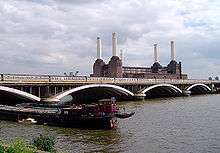Grosvenor Bridge
Coordinates: 51°29′05″N 0°08′51″W / 51.48472°N 0.14750°W
| Grosvenor Bridge | |
|---|---|
 Grosvenor Bridge with Battersea Power Station in the background | |
| Carries | Railway |
| Crosses | River Thames |
| Locale | London, England |
| Preceded by | Chelsea Bridge |
| Followed by | Vauxhall Bridge |
| Characteristics | |
| Design | Arch bridge |
| Total length | 283.5 m (930 ft 1 in) |
| Width | 54 m (177 ft 2 in) |
| Longest span | 53.3 m (174 ft 10 in) |
| History | |
| Opened | 1860; rebuilt 1963-1967 |
Grosvenor Bridge, originally known as, and alternatively called Victoria Railway Bridge, is a railway bridge over the River Thames in London, between Vauxhall Bridge and Chelsea Bridge. Originally constructed in 1860, and widened in 1865 and 1907, the bridge was extensively rebuilt and widened again in the 1960s as an array of ten parallel bridges.
History
The original bridge was constructed in the mid-nineteenth century in two stages: the first bridge was built by the Victoria Station and Pimlico Railway between 1859 and 1860 at a cost of £84,000 to carry two tracks into Victoria Station; it was the first railway bridge across the Thames in central London. The engineer was Sir John Fowler.[1][2]
The bridge was widened by four tracks on the eastern side for the London, Brighton and South Coast Railway and London, Chatham and Dover Railway between 1865 and 1866, at a cost of £245,000. Sir Charles Fox was the engineer.[1][3]
In 1907 the bridge was widened again with a further track, on the western side, for the London, Brighton and South Coast Railway.[1][4]
The bridge was rebuilt in 1963–67: the foundations were extended; the original piers encased in concrete; and the spans replaced with ten steel spans and a tenth track added.[note 1] To avoid disrupting traffic, the bridge was re-built with a separate span for each track. The designer for this work was Freeman Fox & Partners, and the project engineer was A. H. Cantrell, chief civil engineer of the Southern Region of British Rail.[5][6] It was said to be the busiest railway bridge in the world with 1000 trains crossing per day in 1968.[7]
Location
On the north bank is Pimlico to the north and east and Chelsea to the west; the Lister Hospital and the Royal Chelsea Hospital lie immediately to the north west. On the south bank is Nine Elms to the east and Battersea to the west. Battersea Power Station is immediately to the south of the bridge, and Battersea Park to the south west.
See also
Notes
- ↑ The number of tracks was increased from nine to ten without widening the bridge - the tenth track was placed in a space created for gas lines during the 1865 bridge widening, between the 1860 and 1865 piers.
References
- 1 2 3 "Victoria (Grosvenor) Bridge, site of", www.engineering-timelines.com
- ↑ Wilson 1868.
- ↑ Fox 1868.
- ↑ Railway Magazine, 1963, p.533
- ↑ "Railway Bridge Across the Thames" on YouTube
- ↑ Railway Magazine, 1963, pp.534, 542
- ↑ Grolier. The Year Book 1968. p. 41.
Sources
- Wilson, W. (1868). "Description of the Victoria Bridge, on the Line of the Victoria Station and Pimlico Railway. (Includes Plate and Appendix)". Minutes of the Proceedings. 27 (1868): 55. doi:10.1680/imotp.1868.23117.
- Fox, C. D. (1868). "On the Widening of the Victoria Bridge and Approaches to the Victoria Station, and on New Railways at Battersea. (Includes Plates and Appendix)". Minutes of the Proceedings. 27 (1868): 68. doi:10.1680/imotp.1868.23118.
- Kerensky, O. A.; Partridge, F. A. (1967). "The Reconstruction of the Grosvenor Railway Bridge. (over the River Thames)". ICE Proceedings. 36 (4): 721. doi:10.1680/iicep.1967.8471.
- "Reconstruction of the Grosvenor Bridge" (PDF), The Railway Magazine: 533–4, 542, August 1963, republished with permission via www.semgonline.com
- "Railway Bridge Across the Thames", www.youtube.com, British Railways Board, video of 1960s reconstruction
- Grolier. The Year Book 1968. p. 41.
External links
| Wikimedia Commons has media related to Grosvenor Bridge. |
- Grosvenor Bridge, Southern E Group
- Grosvenor Bridge at Structurae
- Where Thames Smooth Waters Glide